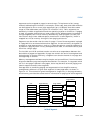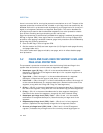
Vol. 3 5-7
PROTECTION
• A doubleword at an offset greater than the (effective-limit – 3)
• A quadword at an offset greater than the (effective-limit – 7)
For expand-down data segments, the segment limit has the same function but is
interpreted differently. Here, the effective limit specifies the last address that is not
allowed to be accessed within the segment; the range of valid offsets is from (effec
-
tive-limit + 1) to FFFFFFFFH if the B flag is set and from (effective-limit + 1) to FFFFH
if the B flag is clear. An expand-down segment has maximum size when the segment
limit is 0.
Limit checking catches programming errors such as runaway code, runaway
subscripts, and invalid pointer calculations. These errors are detected when they
occur, so identification of the cause is easier. Without limit checking, these errors
could overwrite code or data in another segment.
In addition to checking segment limits, the processor also checks descriptor table
limits. The GDTR and IDTR registers contain 16-bit limit values that the processor
uses to prevent programs from selecting a segment descriptors outside the respec-
tive descriptor tables. The LDTR and task registers contain 32-bit segment limit value
(read from the segment descriptors for the current LDT and TSS, respectively). The
processor uses these segment limits to prevent accesses beyond the bounds of the
current LDT and TSS. See
Section 3.5.1, “Segment Descriptor Tables,” for more infor-
mation on the GDT and LDT limit fields; see Section 6.10, “Interrupt Descriptor Table
(IDT),” for more information on the IDT limit field; and see Section 7.2.4, “Task
Register,” for more information on the TSS segment limit field.
5.3.1 Limit Checking in 64-bit Mode
In 64-bit mode, the processor does not perform runtime limit checking on code or
data segments. However, the processor does check descriptor-table limits.
5.4 TYPE CHECKING
Segment descriptors contain type information in two places:
• The S (descriptor type) flag.
• The type field.
The processor uses this information to detect programming errors that result in an
attempt to use a segment or gate in an incorrect or unintended manner.
The S flag indicates whether a descriptor is a system type or a code or data type. The
type field provides 4 additional bits for use in defining various types of code, data,
and system descriptors.
Table 3-1 shows the encoding of the type field for code and
data descriptors; Table 3-2 shows the encoding of the field for system descriptors.


















